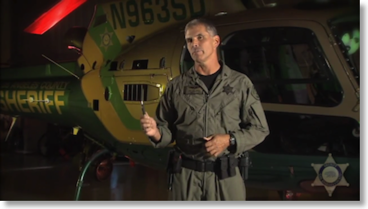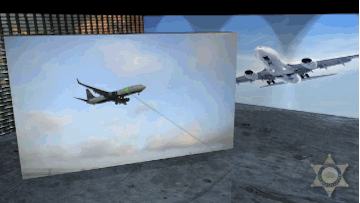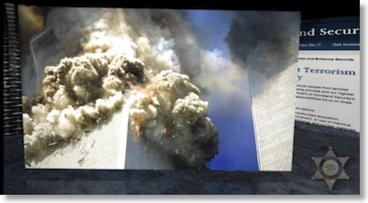Home
A comprehensive resource for safe and responsible laser use
US: L.A. Sheriff's Dept. puts "Laser Strike" info video on YouTube
11 Apr 2013 -- Categories: Aviation incidents | Anti-laser protection | Ways to reduce incidents | SLA news
The Los Angeles County Sheriff’s Department on April 4 2013 uploaded a 13-minute long training video to YouTube called “Laser Strike”. The video was produced in association with the LASD Aero Bureau, the U.S. Department of Homeland Security, and the FBI. In addition, four other “bonus content” videos were uploaded, which feature interviews.

To see the video, click this link to YouTube. Following this link should also lead to the bonus content videos.
To get a flavor of the training video, click the “Read More…” link below for a list of selected excerpts and interesting statements.
Selected excerpts from the L.A. Sheriff’s Department “Laser Strike” video
0:21 -- Narrator: “The aggressive use of the green laser as a tool for escape and distraction by suspects has now become a reality.”
1:00 -- Jon Brick, L.A. Sheriff’s Department Flight Training Sergeant: “In the hands of a suspect, these simple devices can be used as weapons -- weapons that can cause instant blindness, permanent eye damage, and possibly lead to tragedy.”
1:18 -- A graphic is shown of LaserPointerSafety.com’s article entitled “US: Latest 2012 laser/aircraft statistics”. [Thanks for the shout out
DESCRIPTIONS OF LASER STRIKES
2:12 -- L.A. Police Department officer Rennick Brown describes lasers at a laser light show: “At this event there were lasers from the vendor. Now the vendor lasers were passed through the helicopter really quickly. The laser strikes we started to get were strikes that were specifically directed at us and illuminate the cockpit for anywhere from 5 to 10 seconds at one period of time. After the first guy started hitting us with the laser we started getting copycat people inside the Coliseum. The first guy that hit us had a three-prong laser. It’s almost like taking three lasers and taping them together and shooting them at us at one particular time. While we were trying to pinpoint where the unit was that was on the ground that was having trouble with the 415 [disturbance] man, I did utilize my binoculars several times.”
3:01 -- The narrator picks up Brown’s story: “While utilizing the binoculars, LAPD Tactical Flight Officer Brown was struck directly into the eyes. The effects to his eyes from this strike lasted several hours. He experienced a gritty sensation in his eyes when he blinked.”
3:13 -- Desiree Horton, identified as LA News Helicopter Pilot: “I recently received a laser strike where I actually sustained eye damage and we actually encounter laser strikes on an almost nightly basis flying here in Los Angeles when I fly news. And I’ve never actually had eye damage from any of them until this one and I’m not sure what was different about that laser strike, maybe it was a brand-new laser, fresh batteries, the proximity or the guy actually had really good aim and was able to get it inside the cabin of the helicopter. And just looking at it for a couple of seconds was enough to burn my eyes.”
DISCUSSION OF EYE EFFECTS AND INJURIES
4:04 -- Dr. Kevin Miller, MD, Professor of Clinical Ophthalmology - UCLA : “When somebody takes a hit with laser light or any intense light, multiple effects can occur. One is glare, the second is a flash blindness, and the third is afterimages.”

4:41 -- The narrator describes flash blindness as an “injury” that bleaches rods and cones. Flash blindness is illustrated by a graphic (above) showing a laser entering an eye, going onto the retina and the inside of the eye turns red, accompanied by a sizzling sound.
4:46 -- The narrator describes the third effect, after image: “This is the effect you get when you look at a camera flash and see the reversal of an image.” This is illustrated by a photograph that turns from its normal colors into a negative image (like a film camera negative).

5:01 -- Several photos of crashed helicopters are shown (above) while the narrator says: “As stated, if crew members of an aircraft are affected by a laser strike and severe injury to their vision occurs during a critical phase of flight, the pilot may not have adequate time to recover and the consequences could have dire results.”
5:47 - Steve Robertson, Glendale Police helicopter chief pilot is describing a laser strike in the late 1990s: “When it hit me that second time, it was instant pain, it was instant blindness. I equate it to when we’re in the [tear] gas house at the Academy or if you’ve been OC’d [pepper sprayed]. You can’t see.”
6:06 -- Narrator: “With the increase in laser applications, law enforcement must recognize and acknowledge that lasers will be weapons used against us in the near future.”

6:33 -- Images of the September 11 2001 attacks are shown (above) as the narrator says: “With the reality of terrorist planning and the possibility of attacks ever present, any use of lasers -- even as tools to measure, align, or aim -- should not be dealt with lightly. Any application of a laser should be considered in light of homeland security concerns. To combat this problem, law enforcement should know the applicable laws and how to enforce them.”
LAWS
A section on laws then discusses in detail California Penal Code 247.5, dealing with “persons who willfully and maliciously discharge a laser at an occupied aircraft whether in motion or in flight”, and PC 248, which covers “persons who with intent, shine a light at an aircraft, powerful enough to interfere and impair the operation of an aircraft.”
9:13 -- Another graphic from LaserPointerSafety.com, the page shown is from an older version of Sentences for persons convicted of laser offenses
REPORTS
9:31 -- Michael Ramos, San Bernardino County district attorney says that for successful prosecution and prevention, they require “the correct documentation and evidence from all participating agencies, departments and task forces to ensure a successful conviction.” A section on the importance of correct reports then follows.
10:20 -- Information in reports “should include, but are not limited to:
A) Recovered and logged evidence such as the device, packaging, warning labels, and receipts;
B) Statements and log entries from the victim such as altitude, location, number of strikes, deviation from the strike, effects and injuries to crew and law enforcement;
C) Statements made by the suspects related to the intent and/or reason for using and directing the laser at the target;
D) Statements made by the suspects related to the warning labels and cautions associated with the purchase and use of the laser.”
CONCLUSION
11:27 -- Sgt. Jon Brick concludes: “What was once a tool used as a simple pointer, the laser has become a weapon in the wrong hands. With the increase in power and decrease in price, they are increasingly being found in the hands of children and adults who have no idea of their potential danger. We as law enforcement officers mush assure the public and the flight crews we work with that we understand the seriousness of the situation, and that we will respond.”